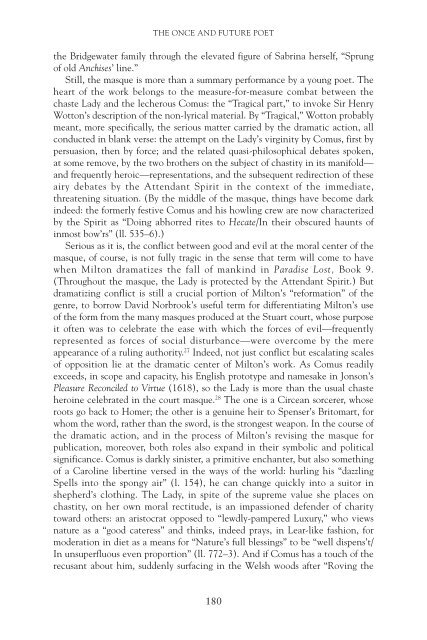ENG LYRIC POETRY.pdf - STIBA Malang
ENG LYRIC POETRY.pdf - STIBA Malang
ENG LYRIC POETRY.pdf - STIBA Malang
Create successful ePaper yourself
Turn your PDF publications into a flip-book with our unique Google optimized e-Paper software.
THE ONCE AND FUTURE POET<br />
the Bridgewater family through the elevated figure of Sabrina herself, “Sprung<br />
of old Anchises’ line.”<br />
Still, the masque is more than a summary performance by a young poet. The<br />
heart of the work belongs to the measure-for-measure combat between the<br />
chaste Lady and the lecherous Comus: the “Tragical part,” to invoke Sir Henry<br />
Wotton’s description of the non-lyrical material. By “Tragical,” Wotton probably<br />
meant, more specifically, the serious matter carried by the dramatic action, all<br />
conducted in blank verse: the attempt on the Lady’s virginity by Comus, first by<br />
persuasion, then by force; and the related quasi-philosophical debates spoken,<br />
at some remove, by the two brothers on the subject of chastity in its manifold—<br />
and frequently heroic—representations, and the subsequent redirection of these<br />
airy debates by the Attendant Spirit in the context of the immediate,<br />
threatening situation. (By the middle of the masque, things have become dark<br />
indeed: the formerly festive Comus and his howling crew are now characterized<br />
by the Spirit as “Doing abhorred rites to Hecate/In their obscured haunts of<br />
inmost bow’rs” (ll. 535–6).)<br />
Serious as it is, the conflict between good and evil at the moral center of the<br />
masque, of course, is not fully tragic in the sense that term will come to have<br />
when Milton dramatizes the fall of mankind in Paradise Lost, Book 9.<br />
(Throughout the masque, the Lady is protected by the Attendant Spirit.) But<br />
dramatizing conflict is still a crucial portion of Milton’s “reformation” of the<br />
genre, to borrow David Norbrook’s useful term for differentiating Milton’s use<br />
of the form from the many masques produced at the Stuart court, whose purpose<br />
it often was to celebrate the ease with which the forces of evil—frequently<br />
represented as forces of social disturbance—were overcome by the mere<br />
appearance of a ruling authority. 27 Indeed, not just conflict but escalating scales<br />
of opposition lie at the dramatic center of Milton’s work. As Comus readily<br />
exceeds, in scope and capacity, his English prototype and namesake in Jonson’s<br />
Pleasure Reconciled to Virtue (1618), so the Lady is more than the usual chaste<br />
heroine celebrated in the court masque. 28 The one is a Circean sorcerer, whose<br />
roots go back to Homer; the other is a genuine heir to Spenser’s Britomart, for<br />
whom the word, rather than the sword, is the strongest weapon. In the course of<br />
the dramatic action, and in the process of Milton’s revising the masque for<br />
publication, moreover, both roles also expand in their symbolic and political<br />
significance. Comus is darkly sinister, a primitive enchanter, but also something<br />
of a Caroline libertine versed in the ways of the world: hurling his “dazzling<br />
Spells into the spongy air” (l. 154), he can change quickly into a suitor in<br />
shepherd’s clothing. The Lady, in spite of the supreme value she places on<br />
chastity, on her own moral rectitude, is an impassioned defender of charity<br />
toward others: an aristocrat opposed to “lewdly-pampered Luxury,” who views<br />
nature as a “good cateress” and thinks, indeed prays, in Lear-like fashion, for<br />
moderation in diet as a means for “Nature’s full blessings” to be “well dispens’t/<br />
In unsuperfluous even proportion” (ll. 772–3). And if Comus has a touch of the<br />
recusant about him, suddenly surfacing in the Welsh woods after “Roving the<br />
180










